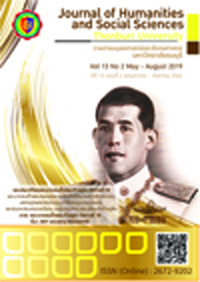THE DYNAMIC DEVELOPMENT OF MULTILINGUAL MENTAL LEXICON AND LEXICAL ACCESS AS THE FUNCTIONS OF LINGUISTIC DISTANCE AND SEMANTIC CHARACTERISTICS REPRESENTED FROM ORDER ENTITIES
Main Article Content
Abstract
The present research is aimed to investigate the influence of different levels of linguistic distance among languages on the development of multilingual mental lexicon and lexical access, to investigate the influence of different order entities on the development of multilingual mental lexicon and lexical access, and to investigate the interaction among different levels of linguistic distance and different word order entities on the development of multilingual mental lexicon and lexical access. The subjects of this study consisted of four groups as (1) 50 Thai-Lao-Cambodia speakers; (2) 50 Thai-Lao-Vietnamese speakers; (3) 50 Thai-English- Cambodia speakers; and (4) 50 Thai-English- Vietnamese speakers. The masked translation equivalent priming tasks were used as the experimental methodology. The results were analyzed using ANOVA and MANOVA. The results revealed that the effect of linguistic distance has the influence on the recognition and development of L2 and L3 and different orders of word entities produced different degree of priming effects. The analysis revealed the significant interaction among linguistic distance, word order entity, prime language status, and target language status. The implementation of results is the development of particular model mental to explain lexicon and lexical access of multilingual speakers.
Article Details
References
Chen, Hsuan-Chih & Ng, Man-Lai (1989). Semantic Facilitation and Translation Priming Effects in Chinese-English Bilinguals. Memory & Cognition, 17(4): 454–462.
Chen, B., Zhou, H., Gao, Y., & Dunlap, S. (2014). Cross-Language Translation Priming Asymmetry with Chinese-English Bilinguals: A Test of the Sense Model. Journal of Psycholinguist Research, 43(3):225-240.
Chiswick, B.R., & Miller, P. W. (1998). English Language Fluency Among Immigrants in the United States. Research in Labor Economics, 17: 151-200.
Chiswick, B.R., & Miller, P. W. (2001). A Model of Destination Language Acquisition: Application to Male Immigrants in Canada. Demography, 38(3): 391-409.
Chiswick, B.R., & Miller, P. W. (2004). Linguistic Distance: A Quantitative Measure of the Distance Between English and Other Languages. Discussion Paper No. 1246. Bonn, Germany: The Institute for the Study of Labor.
Clayton, T. (2006). Language Choice in a Nation under Transition: English Language Spread in Cambodia. Boston, MA: Springer.
Crystal, D. (1987). The Cambridge encyclopedia of language. Cambridge: Cambridge University Press.
de Groot, A. M. B., and Hoeks, J. C. J. (1995). The Development of Bilingual Memory: Evidence from Word Translation by Trilinguals. Language Learning, 45(4), 683-724.
de Groot, A. M. B.; Dannenburg, L.; & van Hell, J. G. (1994). Forward and Backward Word Translation by Bilinguals. Journal of Memory and Language. 33(5): 550-568.
European Commission. (2007). Final Report: High Level Group on Multilingualism. Luxembourg: European Communities.
Gonia, J.;& Libben, G. (2008). The Mental Lexicon: Core Perspectives. United Kingdom: Emerald Group.
Grimes, J.;& Grimes, B.F. (1993). Ethnologue: Languages of the World. Dallas: Summer Institute of Linguistics.
Grosjean, F. (2010). Bilingual: Life and reality. Cambridge, MA: Harvard University Press.
Guardian Newspaper (2016). British and Europe: The survey results. Retrieved from https://www.theguardian.com/uk-news.
Hart-Gonzalez, L. and Lindemann, S. (1993). Expected Achievement in Speaking Proficiency. Mimeo: School of Language Studies, Foreign Services. Institute, Department of State.
Kemp, C. (2009). Defining Multilingualism. In Aronin, L. & Hufeisen, B. (Eds.), The Exploration of Multilingualism: Development of Research on L3, Multilingualism, and Multiple Language Acquisition (pp. 11–26). Amsterdam, the Netherlands: John Benjamins.
Kosonen, K. (2009). Language-In Education Policies in Southeast Asia: An Overview. In Kosonen, K. & Young, C. (Eds.), Mother Tongue as Bridge Language of Instruction: Policies and Experiences in 14 Southeast Asia (pp. 22-41). Bangkok: The Southeast Asia Ministers of Education Organization.
Kroll, J. F. and Stewart, E. (1994). Category Interference in Translation and Picture Naming: Evidence for Asymmetric Connection between Bilingual Memory Representations. Journal of Memory and Language. 33(2): 149-174.
Lambert, W. E., Ignatow,M., & Krauthamer, M. (1968). Bilingual Organization in Free Recall. Journal of Verbal Learning & Verbal Behavior. 7(1): 207-214.
Le, Minh-Hang & O’Harrow, S. (2007). Vietnam. In Simpson, A. (Ed.), Language and National Identity in Asia (pp. 415-441). Oxford: Oxford University Press.
Li, W. (2008). Research Perspectives on Bilingualism and Multilingualism. In Li, W. and Moyer, M. (Eds.), The Blackwell Handbook of Research Methods on Bilingualism and Multilingualism (pp.3–17). Oxford, UK: Blackwell.
Lyons, J. (1977). Semantics. Cambridge: CUP.
Neou Sun. (2009). Education Policies for Ethnic Minorities in Cambodia. Kosonen, K. & Young, C. (Eds.), Mother Tongue as Bridge Language of Instruction: Policies and Experiences in 14 Southeast Asia (pp. 62-68). Bangkok: The Southeast Asia Ministers of Education Organization.
Oldfield, R. C. (1966). Things, Words, and the Brain. The Quarterly Journal of Experimental Psychology. 18(4): 340-353.
Pinker ,S., & Jackendoff, R. (2005).The faculty of language: what's special about it? Cognition, 95, 201-236.
Potter, M. C., So, K.-f., von Eckardt, B., & Feldman, L. B. (1984). Lexical and Conceptual Representation in Beginning and Proficient Bilinguals. Journal of Verbal Learning & Verbal Behavior. 23(1): 23-38.
Roux, P.W. (2013). Words in the Mind: Exploring the Relationship between Word Association and Lexical Development. Polyglossia. 24: 80–91.
Singleton, D. (1999). Exploring the Second Language Mental Lexicon. Cambridge: Cambridge. University Press.
Soranastaporn, S. (2017). Language Learning Strategies of Thai Learners in Thailand 4.0. Journal of Thonburi University, 11(60): 9-23.
Sudasna Na Ayudhya, P. (2017). The Development of Thai-English-Vietnamese-Lao-Burmese-Bahasa-Filipino Languages of Common Base Concepts of 1st-3rd Order Entity Wordnet for Internet Usage. (Research Report, Bansomdejchaopraya Rajabhat University, granted by ThailandResearch Fund).
Thomas, A. (2002). Bilingual Community-Based Education in the Cambodian Highlands: A Successful Approach to Enabling Access to Education by Indigenous Peoples. Journal of Southeast Asian Education, 3(1): 26-55.

